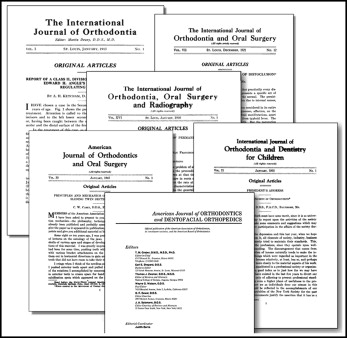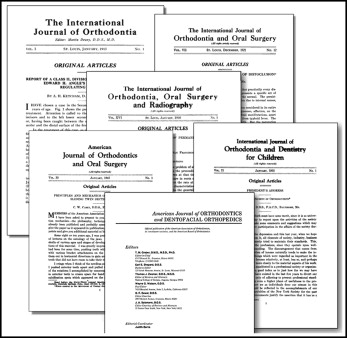With more than a few early attempts to start the first specialty journal of orthodontia, it took a push by C. V. Mosby to get the job done in 1915. After Edward H. Angle declined the first editorship, the publisher settled on a graduate of the Angle School, Martin Dewey. Dewey’s initial reluctance evaporated once he received the support of Bernhard W. Weinberger, who had already mined the fields of dental journalism with the publication of several articles describing the history of dentistry. In the 12 issues of Volume 1 of the International Journal of Orthodontia , you will find editorials by Martin Dewey; a series of history articles by B. W. Weinberger; research reports from A. H. Ketcham, William H. Bolton, and F. B. Noyes; case reports by B. E. Lischer and others; reviews and comments from future editor H. C. Pollock; and more.
The cost of printing was high in the early years of the 20th century, and the editor worked hard to fill each modest issue. Despite the early problems, the Journal flourished. As we pause in 2015 to acknowledge the many contributions our Journal has made to the evolving specialty of orthodontics, it seems appropriate to look back on what we have achieved. Others have written or will write about the early years of journal publishing; in this article, I will review some of the challenges we met in the last quarter century, including the changing role of the editor, copyright ownership, peer review, potential for conflicts of interest, evolving standards for evidence-based dentistry, and the challenge of keeping case reports relevant, even after 100 years of publishing them.
Challenges and opportunities faced by dental editors
Over the 100 years of Journal operation there have been only 8 editors, and some served many years with little support. However, the level of support by the specialty of orthodontics has increased markedly over the past 30 years.
Martin Dewey, 1915-1931
H. C. Pollock, 1931-1968
B. F. Dewel, 1968-1978
Wayne G. Watson, 1978-1985
Tom Graber, 1985-2000
David L. Turpin, 2000-2010
Vincent G. Kokich, 2010-2013
David L. Turpin, 2013-2014
Rolf G. Behrents, 2014-present
These editors all had opportunities to improve the Journal , and each contributed in his own way when the time was right. For a journal that strives to serve orthodontic clinicians and researchers, it only makes sense to look to an organization that has been supporting dentistry meaningfully for nearly a century to learn more about editorial changes. The American College of Dentists, founded in 1920, devoted an entire issue of its journal to “Advice for a young editor.” That advice is well worth considering as we celebrate the first 100 years of the AJO-DO .
- •
The first responsibility of the editor is to the readers. The editor should work to ensure that content is from reputable sources, factually accurate, balanced, and unbiased. Personal opinion should be labeled as such, with potential conflicts of interest disclosed. The publication should be readable and based on a standardized style with careful editing for grammar and clarity. Opportunity should be provided for alternative opinions when possible.
- •
The second responsibility of the editor, representing the professional community, is to the authors. The editor should promote the dignity of the specialty, regularly publishing the standards for the selection of content and the format for submission of material. All material should be reviewed by competent experts in the field, in a fashion that is timely, confidential, and constructive. Standards should be set for peer review and the rules under which they operate enforced.
- •
The third responsibility of the editor is to the organization publishing the journal: in this case, the American Association of Orthodontists (AAO). The editor should diligently avoid placing the sponsoring organization in a legally questionable position. He or she should respect the terms of employment, fully understanding what is expected as both an editor and a participant on various committees, task forces, annual meetings, and so on. The editor should ensure that the advertising is in good taste and does not violate the association’s advertising guidelines.
- •
The fourth responsibility of the editor is to the community of editors. This means that the editor should regularly seek advice and be open to guidance from peers. The editor should endorse policy covering republication and other use of published material, and be open to incorporating new forms of communication, such as videos and blogs. In all formats used, the editor should have the final say over the content of the publication.
Excellent journalism can help to merge scientific findings with patient needs, influencing treatment plans and leading to improved outcomes. A specialty whose members can express themselves via the publication of properly conducted clinical research can enrich untold numbers of people throughout the world—both colleagues and the public at large.
Journal ownership
Every editor changed the journal, improving it in myriad ways. One thing that changed often is the Journal’s name ( Fig 1 ). In a 1976 editorial, Tod Dewel (editor-in-chief, 1968-1978) recommended that the name be modified to include Dentofacial Orthopedics . Wayne Watson (editor-in-chief, 1978-1985) added “A Journal of Dentofacial Orthopedics” in 1980, and Tom Graber (editor-in-chief, 1985-2000) pushed the name change a bit farther. The journal is likely to remain the American Journal of Orthodontics and Dentofacial Orthopedics for years into the future, although reverting to the originally used term, International , might be more appropriate now than at any time in the past. The number of international members of the AAO is at an all-time high, and it is perhaps only a matter of time until the next editor-in-chief is multilingual with roots in another country.

Throughout all the years and all the changes, the C. V. Mosby Company owned the journal. The editor, representing the AAO, had full control of what was published, but the publisher owned the name and content. In 1994, Tom Graber made a critical decision regarding journal ownership. In the business of scientific publications, it was typical for publishers and associations to negotiate a new contract every 5 or 6 years. By 1994, Dr Graber had already been through 1 contract negotiation and knew how it worked. He could also see that computers and digital technology were changing the face of publishing, and so perhaps he decided to play “hardball” the next time around. To secure full ownership of the journal, would Graber actually pull it away from Mosby, change the name, and start all over again with a new publisher? I don’t know, but other journals had recently changed publishers (including The Angle Orthodontist and the Journal of the American Dental Association ); the Mosby company must have been sufficiently convinced that this was a possibility, because it agreed to transfer total ownership over a period of time as terms of the new contract. I have no proof, but I firmly believe that the Mosby employee who agreed to this transfer of ownership knew that the publisher would not want to lose a client that had been with the company since 1915. This Journal had been a cornerstone of Mosby’s strong reputation in the world of scientific publications. Regardless of the details, the outcome of this gamble is clear: from 1994 to the present, the AAO has fully controlled and now owns all rights to the Journal . The Mosby Co. is now part of Elsevier. Since 1994, the AAO and Elsevier have steadily invested in placing all archived material online, making it easily accessible back to the first issue in 1915. Because of his gutsy move, Tom Graber deserves much of the credit for this being possible in the complex world of copyright ownership.
Journal ownership
Every editor changed the journal, improving it in myriad ways. One thing that changed often is the Journal’s name ( Fig 1 ). In a 1976 editorial, Tod Dewel (editor-in-chief, 1968-1978) recommended that the name be modified to include Dentofacial Orthopedics . Wayne Watson (editor-in-chief, 1978-1985) added “A Journal of Dentofacial Orthopedics” in 1980, and Tom Graber (editor-in-chief, 1985-2000) pushed the name change a bit farther. The journal is likely to remain the American Journal of Orthodontics and Dentofacial Orthopedics for years into the future, although reverting to the originally used term, International , might be more appropriate now than at any time in the past. The number of international members of the AAO is at an all-time high, and it is perhaps only a matter of time until the next editor-in-chief is multilingual with roots in another country.





